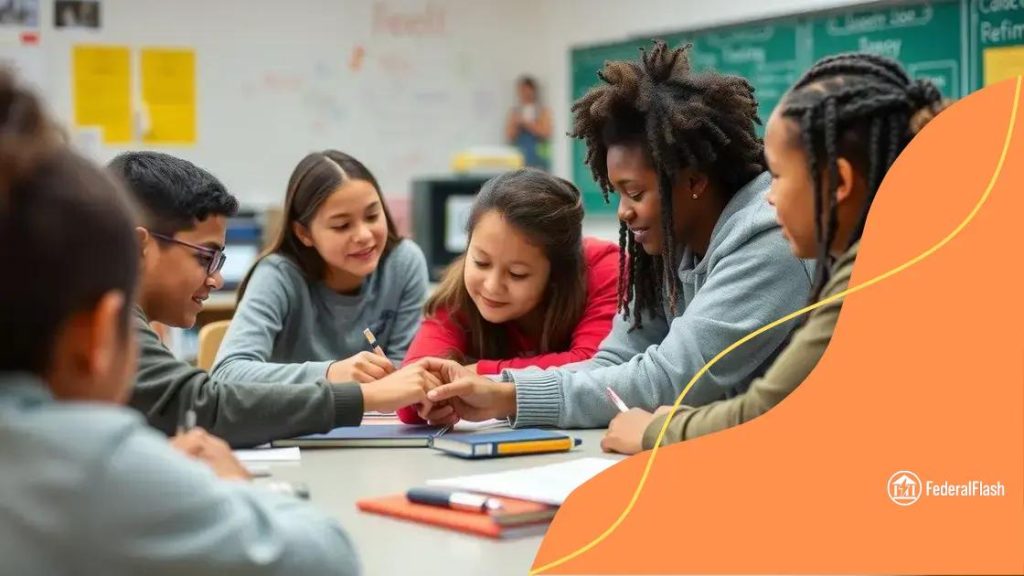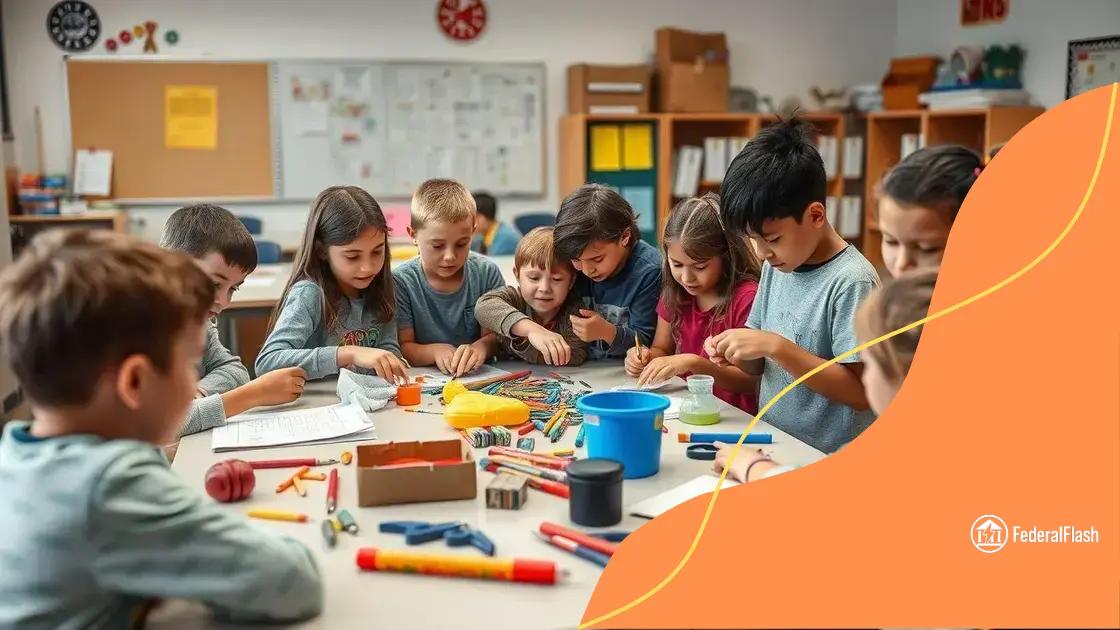Project-based learning in focus: unlocking student engagement

Anúncios
Project-based learning engages students through hands-on projects that address real-world problems, fostering critical thinking, collaboration, and a deeper understanding of the subject matter.
Project-based learning in focus offers a refreshing approach to education, engaging students in meaningful ways. Have you ever wondered how hands-on projects can spark creativity and collaboration? Let’s explore this innovative teaching method.
Anúncios
Understanding project-based learning
Understanding project-based learning is essential for educators looking to engage their students effectively. This approach focuses on real-world problem solving, allowing students to take control of their own learning.
At its core, project-based learning encourages collaboration and creativity. Students engage in projects that are both meaningful and relevant to their lives. This method not only fosters critical thinking but also builds essential skills like teamwork and communication.
Key Elements of Project-Based Learning
By incorporating the following elements, educators can enhance the effectiveness of project-based learning:
Anúncios
- Real-World Connections: Projects should relate to the students’ lives, making learning more relevant.
- Student Choice: Empowering students to choose their projects increases motivation.
- Reflection: Encouraging students to reflect on their learning fosters deeper understanding.
- Collaboration: Students work together, allowing them to learn from each other.
Project-based learning also allows for the integration of various subjects. For example, a project on environmental science can incorporate math by measuring data or language arts by writing reports. This cross-disciplinary approach creates a richer learning experience.
Furthermore, assessments in project-based learning often go beyond traditional tests. Instead, teachers evaluate students based on their ability to apply their knowledge in real-world situations. This can include presentations, reports, and peer evaluations, which provide a more comprehensive view of student understanding.
Ultimately, the goal of project-based learning is to prepare students for the challenges of the future. By engaging them in meaningful projects, we help them develop a love for learning and the skills they need to succeed.
Key benefits for students and teachers
The key benefits of project-based learning extend to both students and teachers, creating a vibrant educational environment. This method not only engages students but also enhances teaching practices.
One major benefit for students is increased motivation. When learners work on projects that pique their interest, they become more invested in their education. This enthusiasm often leads to better retention of information and skills.
Benefits for Students
Consider the following advantages:
- Critical Thinking Skills: Students learn to analyze problems and develop solutions.
- Engagement: Hands-on projects keep students interested and involved.
- Collaboration: Working in teams helps students improve their communication skills.
- Real-World Applications: Projects relate classroom learning to real-life situations.
Equally important are the benefits for teachers. Educators find that project-based learning allows them to connect with students on a deeper level. They can observe how their students think and collaborate, which provides valuable insights into their learning processes.
Benefits for Teachers
Teachers gain several advantages from this approach:
- Facilitates Differentiation: Educators can tailor projects to meet diverse learning needs.
- Increases Student Accountability: Students are more responsible for their own learning in project-based settings.
- Professional Development: Teachers hone their skills by adopting new teaching methods.
- Enhances Classroom Dynamics: A collaborative environment fosters positive relationships among students and teachers.
As both students and teachers engage in project-based learning, the overall classroom atmosphere becomes more dynamic and interactive. This method promotes a love for learning, encouraging both parties to explore, ask questions, and grow together.
How to implement project-based learning

Implementing project-based learning in your classroom can transform how students engage with content. This educational approach encourages students to explore real-world problems and develop solutions through hands-on experiences.
To begin, consider starting with a clear learning objective. This will guide the project’s direction and ensure it aligns with curriculum goals. Choose a topic that resonates with your students and prompts their curiosity.
Steps to Implement Project-Based Learning
Here are some key steps to help you effectively implement project-based learning:
- Identify Learning Outcomes: Clearly define what you want students to achieve.
- Choose a Relevant Project: Select a project that connects to students’ interests or current events.
- Plan the Project Timeline: Outline key milestones and deadlines to keep students on track.
- Gather Resources: Provide access to materials and tools needed for the project.
Collaboration is crucial in project-based learning. Encourage students to work in teams, allowing them to share ideas and skills. This cooperation not only enhances learning but also builds important social skills.
Facilitating Student Learning
Throughout the project, act as a facilitator rather than a traditional teacher. Guide students in their exploration, ask open-ended questions, and encourage them to seek answers themselves. This approach fosters critical thinking and independence.
Provide feedback during the process. Regular check-ins help students stay focused and allow for adjustments to their projects as needed. Communication is key to ensuring that students understand their progress and any necessary changes.
As students tackle challenges within the project, they develop resilience and problem-solving skills. By allowing them to navigate obstacles and find solutions, you create an environment of support and growth.
Lastly, celebrate their achievements. Presentations or exhibitions of their work foster a sense of pride and accomplishment. This not only boosts confidence but also reinforces their learning through sharing with peers.
Examples of successful projects
Exploring examples of successful projects can inspire both educators and students. These project-based learning examples highlight the diversity and creativity possible in the classroom.
One notable project is the “Community Garden” initiative. In this project, students design and create a garden that benefits their local community. They learn about biology, sustainability, and teamwork while working together to bring their vision to life.
Project Examples
Here are some more examples of successful projects:
- Renewable Energy Fair: Students research various renewable energy sources and create models to showcase at a school fair.
- Historical Documentary: Groups of students create documentaries on local history, combining research, storytelling, and technology skills.
- Science and Art Fusion: In this project, students explore the intersection of science and art by creating artistic representations of scientific concepts.
- Global Issues Action Project: Students select a global issue, research its impact, and propose solutions while engaging the community in awareness activities.
Each of these projects demonstrates how students can immerse themselves in learning through real-life applications. The collaboration involved in these projects fosters a sense of community among students.
Benefits of Showcasing Projects
When students present their projects, it builds confidence and reinforces their learning. They take pride in showcasing their hard work to peers, teachers, and parents. Additionally, sharing these projects allows for peer feedback, which encourages further growth and innovation.
Incorporating success stories like these into project-based learning helps new educators visualize the possibilities. This not only motivates teachers to adopt similar projects but also excites students about the learning process.
Challenges and solutions in project-based learning
Challenges in project-based learning can arise, but recognizing them helps educators find effective solutions. Understanding these hurdles is key to successfully implementing this teaching method.
One common challenge is time management. Projects can take longer than traditional lessons. To address this, teachers can break projects into smaller, manageable tasks with clear deadlines. This approach keeps students focused and helps them develop time-management skills.
Common Challenges
Other frequent challenges include:
- Resource Availability: Limited materials can hinder project execution. Teachers can seek partnerships with community organizations for resources.
- Diverse Learning Styles: Students may have different strengths and weaknesses. Differentiating tasks allows all students to contribute meaningfully.
- Assessment Difficulties: Grading project work can be tricky. Implementing rubrics that detail expectations ensures fairness and clarity.
- Student Engagement: Not all students may find projects interesting. Allowing student choice in project topics can increase motivation and engagement.
Facilitating collaboration among students often poses its own set of challenges. Some groups may struggle to communicate effectively. Teaching students collaboration strategies, like assigning specific roles within teams, can enhance teamwork and productivity.
Solutions to Overcome Challenges
Incorporating regular feedback is another way to tackle challenges. Check-ins throughout the project allow students to reflect on their progress and make necessary adjustments. Furthermore, using technology to facilitate collaboration can help bridge gaps in communication and organization.
Finally, fostering a supportive classroom environment encourages risk-taking and creativity. When students feel safe to express their ideas and opinions, they are more likely to engage fully in their projects. Sharing experiences and learning from mistakes creates a positive atmosphere for learning.
FAQ – Frequently Asked Questions about Project-Based Learning
What is project-based learning?
Project-based learning is an educational approach where students engage in real-world projects, allowing them to explore and apply their knowledge actively.
How can project-based learning benefit my classroom?
This method increases student engagement, fosters collaboration, and helps develop critical thinking and problem-solving skills.
What challenges might I face with project-based learning?
Common challenges include time management, resource availability, and ensuring all students are engaged. However, effective planning and support can help overcome these obstacles.
How can I assess student projects effectively?
Use clear rubrics that outline expectations for each project. This ensures fair grading and allows students to understand what is required for success.